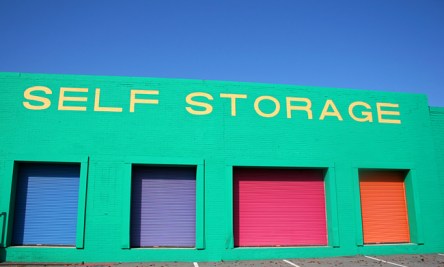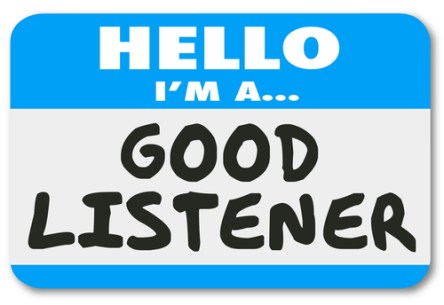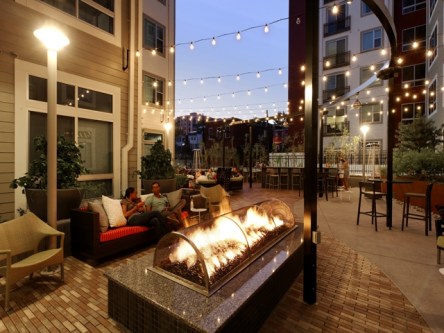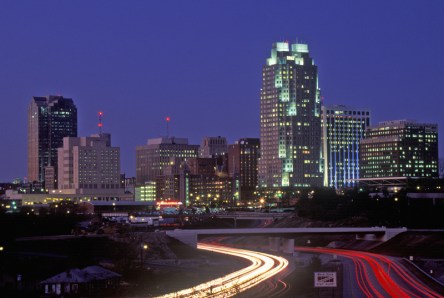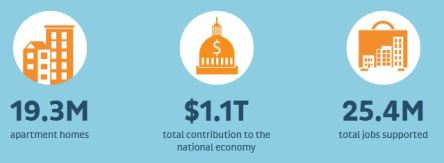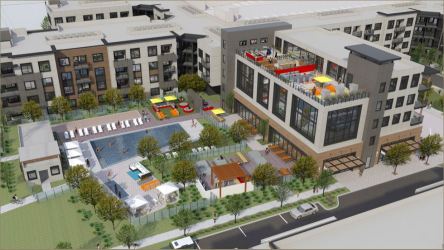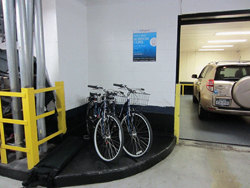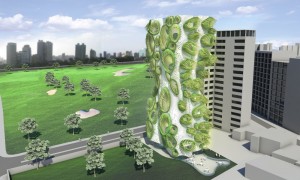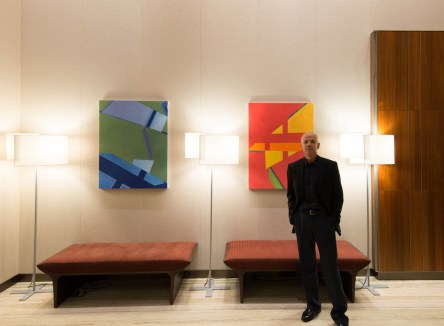More than 37 million U.S. apartment residents receive enormous numbers of holiday packages every year. A load that large requires more than mere tracking numbers. For that reason, one in four apartment communities use specialized software to manage residents’ packages on site. These are among the findings from the National Multifamily Housing Council (NMHC) and Kingsley Associates’ 2014 Package Delivery Survey. The survey was fielded in October of this year, with 2,758 community managers from 28 leading firms responding. The survey also found that during the holiday season, a typical apartment community can receive double the typical 100 packages received weekly. After all, consumers spent $2.3 billion on Cyber Monday in 2013 alone. In more than three-quarters (77 percent) of apartment buildings surveyed, package carriers try to deliver to the door, as opposed to going to the manager’s office, but the number drops to one in five (20 percent) in high rises. If residents aren’t in, carriers take packages to the management office 70 percent of the time. This results in an enormous number of packages for the community manager to handle. “Managing deliveries is a real issue facing the industry,” says David Smith, chief operating officer and vice president, San Francisco-based Kingsley Associates. “There is inherent risk and valuable time associated with sorting, storing and notifying residents of package deliveries at the community level. Senior executives are clearly taking note of the escalating staff hours spent managing the process, particularly during the holidays.” Many apartment companies are increasingly adopting software solutions to help them get a handle on packages. Almost one-quarter, or 24 percent, of properties utilize software to track packages and notify residents. Among high-rise apartment communities, 60 percent are relying on specialized software. Apartment managers are as likely to notify residents...
7 Winter Defenses
Maintenance Tips
Winter is in full swing, bringing with it unpredictable cold fronts and unpleasant, icy storms. Keep your property and residents safe with these simple tips for winterizing your apartments. For Owners HVAC Tune-up Seasonal inspections of your heating and cooling systems will ensure that they are operating at optimal efficiency. It’s also a great idea to make sure that ducts are properly sealed and insulated, which can cut costs by 20 percent or more according to EnergyStar.gov. Stock Up on Salt Make sure that you have enough salt to help defrost walkways, exterior stairways, and inclines throughout the parking lot, entrances, and exits. If the weather drops below 16 degrees for several hours, you may consider a beet juice, molasses, and cheese brine defrosting cocktail. If your community rarely experiences freezes and doesn’t have a plan in place, speak with your maintenance team to set a schedule or assign a technician in charge of defrosting the premises. No one wants to be surprised with such a task at 4am. Arborist Inspection Have an arborist inspect trees for rot, damage, disease, and pests. Branches that are weighed down by snow and ice are prone to fall when they’re already weak. The National Storm Damage Center reports that trees damaged by severe weather cause more than $1 billion in property damage each year. The arborist’s inspection could save you millions by preventing property damage and injury to your residents. Text Alerts If your property does not have a text-alert system for residents, consider establishing one. Use this system to notify residents of extreme weather conditions and fallen trees across nearby thoroughfares. It’s a small touch that can save time and keep residents safe. Extinguisher Check Be sure that fire extinguishers are inspected per fire department code. Scheduling inspections in the...
Self Storage
A "sneaky big" industry
When considering some of the nation’s most profitable industries, what do you think of? The NFL? Entertainment? Self-storage? Surprisingly to most, self-storage outperforms a number of glossier industries. “The self-storage sector is sneaky big,” says Michael Scanlon, president and CEO of the Self Storage Association. “In 2013, all 30 teams in the NFL generated $9 billion in total revenue, while the music industry generated about $21 billion, and self-storage generated $24 billion.” The sneaky big industry has the attention of major investors. During the recession, several sectors of commercial and residential real estate suffered. Other than a minor sigh, the self-storage market held its own. Investors began to pump support into self-storage, reaping promising rewards. “We’re seeing double-digit increases in revenue and occupancy across the country, and developers are hitting near 100 percent occupancy in less than two years after opening where it used to take three years,” reports Adam Schlosser, associate director of the Marcus & Millichap national self-storage group. “The REITs in particular are flowing massive amounts of capital into self-storage. They’re well-capitalized and with new technology can afford aggressive purchase numbers. They know they can increase their revenue stream with acquisitions. We’ve seen more large deals in the past two years than in the past 10 years.” What’s so sexy about self-storage? Absolutely nothing. It’s a practical business that just so happened to benefit from the recession: former homeowners and business owners sought storage for their goods until things looked up again; Millennials who moved back in with their parents needed a place to store their pool tables and ultra-modern, ultra-uncomfortable furniture; as vacations became shorter and more budget-friendly, the family jet skis and boats needed a safe place to rest. Self-storage awaited those in need with open arms. Reports suggest...
Resident Retention
Better Communication
Reducing turnover (and loss of revenue) requires multiple factors working together in harmony, such as a great location, beautiful homes and amenities, and a maintenance crew that is always on point. But perhaps most importantly, the relationship that renters build with the onsite staff can make or break a lease renewal. Fortunately for onsite staff, developing good social skills won’t require an additional line in the budget and it can make a world of difference for retention. Let’s take a look at three points that can improve relationships between staff and residents, leading to happier days and longer stays. Visual Connection It’s a basic social convention that many of us avoid for one reason or another but eye contact is a skill that will take you far in multi-family services. Eye contact is vital for successful during face-to-face communication, whether you are the listener or the speaker. Studies show that listeners are more likely to trust what you say and have confidence in your abilities when you visually connect with them. As you listen, eye contact becomes equally important. When you fail to make eye contact with your residents, you risk conveying: A lack of interest in the speaker: “I’m too busy to pay attention to you.” A lack of interest in the matter at hand: “Oh look… a squirrel is outside.” Dishonesty: “I can’t look him in the eyes while I try to wiggle out of this.” Dominance: “You’re unworthy of my attention.” A lack of eye contact can put a resident in defensive mode, offended by your nonverbal cues and ready to counterattack. This can quickly turn a simple complaint or concern into an argument. The resident will be harder to please and more likely to express aggression on review boards and...
Ebola in America
Aware and Prepared
With the Center for Disease Control (CDC) estimating a potential 1.4 million Ebola hemorrhagic fever cases in West Africa by January 2015 and countless more abroad, it’s worthwhile to investigate how property managers should handle any potential cases at properties in their area. Perspective While Ebola is a serious concern, it is far from a large-scale emergency outside of West Africa. Guinea, Liberia, and Sierra Leone have reported the most cases in 2014. To date, there have only been nine confirmed cases of Ebola in the US, with one fatality, six recoveries, and the remainder currently in recovery. That’s less than 1/2,000,000th of the population currently at risk. While it is a small percentage for sure, it’s not one to be ignored. Educating Residents Well-educated residents can make the most informed decisions about their own health and well-being. This is important because individuals know their travel history, social sphere, and can evaluate their own health much better than you can from the office. Post helpful information in a visible place within your leasing office: According to the CDC, “Ebola is only contagious if the person is experiencing active symptoms.” Active symptoms include fever (greater than 101.5°F), severe headache, muscle pain, weakness, diarrhea, vomiting, abdominal pain, and unexplained bleeding or bruising. These symptoms will occur anywhere from two to 21 days from exposure with most symptoms occurring within in the first week or so. Residents displaying multiple symptoms should contact health officials particularly if: The have traveled to the aforementioned West African nations within the last few weeks. They have experienced direct contact with the blood, excrement, saliva, urine, vomit, sweat, breast milk or semen of a person who is sick with Ebola. They have participated in a ritual (traditional burial) of a person who has died from...
Lifestyle Oriented
Multifamily goes swank
Resort-inspired waterparks. Cultural cafés. Vegetated roofs. Walking and biking trails inviting to active lifestyles. These features may not have had a place in urban residential developments in the past but they are now a gratifying reality. Today’s multi-family communities offer much more than just a place to live. They have evolved into inclusive live-work-play environments where emphasis is laid on occupant health and well-being. Strong demand for rental housing combined with a prospering economy and consistent population growth have allowed developers to deliver an enhanced product, abounding in contemporary design elements, tech offerings and quality services. Many communities around the country are being rebranded, reinvented or revitalized so as to cater to the lifestyle needs of the nation’s key renter demographic, the so-called Millennials. Award-winning national architecture and planning firm KTGY Group, Inc.’s thought-leader Rohit Anand, AIA, NCARB, and the managing principal in KTGY’s Tysons, Va. office, says that Millennials, defined by many demographers as ranging from ages 18 to 37, make up the largest population segment the U.S. has ever seen. “Millennials have many names. They have been referred to as Generation Y (the generation to succeed Generation X), The Echo Boomers (refers to the fact that many Millennials are children of Baby Boomers), The Net Generation (since Millennials grew up with the Internet), The Boomerang Generation (since so many Millennials move back in with their parents after going away to college) and The Peter Pan Generation (due to that so many Millennials delay the rites of passage into adulthood longer than most generations before them),” Anand said. “The Millennial generation has already made a big impact on student housing. The number of students enrolled in college in the U.S. climbed by 30% from 2000 to 2011, helping to fuel a building boom...
Halloween Safety
For All Treats, Fewer Tricks
During this time of year, your office is likely gearing up for ghoul-themed, candy-laden parties for your residents. A few simple tricks can help minimize risks to guests and keep your Halloween party fun and fright free. On the day of the event, you’ll likely be busy running through the office, putting up last minute decorations and arranging the food. That’s why it’s worthwhile to print a safety checklist. Decorating and Activities Make sure that hanging bats and flying ghosts are properly supported. Tug a little to make sure that you encounter resistance. Be mindful that if it’s low enough for a child to pull, a child will pull it. Avoid unnecessary fire hazards by inserting LED “candles” or glow sticks into jack-o-lanterns and glowing décor. It never hurts to have an officer on guard. Simply having the patrol car in the front of the community will remind residents to abide by the speed limit as trick-or-treaters are making their rounds. For pumpkin carving contests, minimize risk of injury by providing markers and other alternative decorating items for younger participants. Electronics Ensure that any cords that run through a walkway are smoothed out and visible to guests. If you’re fortunate enough to have warm weather in October, practice pool safety. Set up electronics a safe distance from the pool. What’s enough space? Imagine that the item fell over. If it would land in the pool, it’s too close. A few nights before, be sure to have the maintenance crew check the property for inadequate lighting, damaged lamps, or burned-out bulbs. Have all lighting in top-notch condition before trick-or-treating festivities. Food and Beverage Selling or offering drink tickets is a convenient way to moderate alcohol intake at adult parties. Severe food allergies are a buzz...
Generation Rent
Demographics Impact Demand
The apartment industry has played a major part in the revitalization of the real estate sector while also significantly contributing to the American economy. Rental market activity has grown at a moderate yet constant pace in most metros around the country, with up to seven million new renter households forming the last decade—almost half of all new households, according to data from the National Apartment Association (NAA) and the National Multi Housing Council (NMHC). The post-recession slowdown in construction has translated into a tight housing market with low inventory levels and climbing rental rates. Corroborated with the massive influx of new renters entering the market, the multi-family sector is poised for more growth in 2014. It would take approximately 300,000 to 400,000 new apartments each year to meet current demand, yet just 158,000 apartments were delivered in 2012. Tech-savvy young professionals generally identified as members of the Gen Y cohort have long been considered the most influential renter demographic for the apartment sector. However, a new type of renter has recently showed up on the real estate radar, which may well reshape the residential market in the coming years. Several industry leaders seem to think that baby boomers could become a key renter demographic in the coming years as empty nesters move out of the houses where they raised families and downsize into cozier, more sustainable apartment units. A Research Notes recently published by the National Multi Housing Council aims to provide some perspective on the issue by analyzing the effect of two key demographic trends: the increasing population and the changing age distribution of that population. NMHC reviews several aspects impacting the nation’s housing choices including demographic, economic and lifestyle trends. Demographics influencing demand. A simple look at census data shows the population...
Happy Residents
Fostering customer satisfaction
Care to know which cities in the United States are home to the most satisfied apartment residents? A recent report released by J Turner Research, a Houston-based company that exclusively specializes in market research for the multifamily industry, identifies Raleigh, North Carolina, as the nation’s hub for happy renters. The study, The Digital Mirror: Online Rankings and Reflection, tracked and analyzed the online reputation of 46, 000 apartment properties in 131 cities nationwide. Based on an aggregate scoring scale of 1-100, the national average score in online customer satisfaction was 47. “Online reputation is fast altering the dynamics of every industry” observes Joseph Batdorf, President, J Turner Research. “The apartment industry is no different. The digital world offers an instant and influential platform for residents to make their voices heard. Residents across the nation have expressed their opinions to rate properties and J Turner has analyzed those ratings to determine the cities offering the highest customer satisfaction in the apartment industry”. Raleigh, North Carolina, ruled the charts in 2013, standing out as the ‘Happiest City’ in online customer satisfaction by apartment renters with a final score of 54. According to the study, prospects in Raleigh may call themselves lucky as the chances of them landing a property that is rated at or higher than the national average are 68 percent higher than anywhere else. Cincinnati, Ohio came in second with a final score of 52; Washington, DC was ranked third with a final score of 51; Chicago, Illinois; Modesto, California; and Knoxville, Tennessee, also made the top ten with a score of 51. On the other end of the customer satisfaction index stands Aurora, Colorado. It seems that residents of Aurora have not had the best of luck with their apartment choices. The study...
A Big Impact
Apartments and the economy
They’re the housing option of choice for millions of Americans, and have gained both development momentum and resident popularity over the last five years. But apartments are not just a roof over our heads at night. They are businesses that provide a major contribution to the U.S. economy. as illustrated by this infographic from the National Apartment Association and National Multifamily Housing Council. WeAreApartments.org offers you the chance to measure the economic impact of an apartment community of any size in any U.S. state. Simply navigate to http://weareapartments.org/calculator/search and enter a few basic points of information, and you can find out how much the apartment community you own or manage contributes to the community – both in operations and thanks to the residents who live there. For a broader view of the Trillion Dollar Apartment Industry, check out this infographic: Source: http://weareapartments.org/ ...
Modern Company Town
Facebook builds apartments
Facebook employees in California are about to find out what it means to reside in a modern version of the historic “company town”. The social media giant is working with Yardi client St. Anton Partners, a local multi-family development and investment company, to develop an upscale multi-housing complex within walking distance of Facebook’s existing Menlo Park headquarters and their new West Campus, which is currently under construction. Designed by national architecture firm KTGY Group, Inc., the multifamily compound was envisioned as a cohesive live/work/play environment where practical design meets style and comfort. Dubbed Anton Menlo, the infill redevelopment project represents the Menlo Park City’s first significant new apartment building in over 20 years. “At over 630,000 sq. ft., this project is one of the largest new construction rental residential projects in the state. We’re pleased to bring it to where housing is needed most,” noted Peter Geremia, co-founder of St. Anton Partners, in a written statement. The site recently received its final zoning approval from the City Council and is currently in the design review phase with City staff, according to official statements. “We are thrilled to have new housing options coming to the City of Menlo Park to serve the Silicon Valley and the Marsh Road and Willow Road business areas,” said City of Menlo Park Mayor Peter Ohtaki. “Providing new housing opportunities for employees working in the area will allow people to live where they work and to spend more time enjoying this great city.” To be located on a piece of formerly industrial land, a 10-acre tract near Marsh Road off of Highway 101, the $120 million community will comprise 394 apartment homes primarily designed to meet the needs of today’s sophisticated renters. It will offer a mix of floor plans...
Bike Sharing
Awesome apartment amenity
Bikes are extremely attractive to apartment renters who live in urban areas. After all, bikes are green, they don’t take up a lot of space and riding is great exercise. Plus they allow riders to avoid being stuck in city traffic jams, which alone makes up for the cost of the bike. Many apartments already provide bicycle storage areas for their residents, either included with the apartment, or for a small amenity fee. I want to ride my bicycle, I want to ride my bike. I want to ride my bicycle, Anywhere I like. —“Bicycle Race,” Queen And, with the popularity of bikes soaring, some communities are taking the bicycle amenity one step further with resident bike-sharing programs. Take, for example, Related Companies. Related, partnering with bike-sharing company Zagster, is going to start offering an on-site bike sharing program in its New York communities. Once residents join the program, they can send a text to reserve a bike (which will be located in their community’s garage or parking lot) for the whole day. The bike keys will all be conveniently located in lock boxes on-site. Bikes will all include large baskets, making them ideal for residents who need to run a few errands—perfect for city dwellers who might not have easy access to a car. A bike-sharing program will save residents money, as well as storage space in their apartments if their community doesn’t have a bicycle storage area. It also provides a great amenity that will actually be used. And it’s eco-friendly. Beyond a little helmet hair, a bike-sharing program could be a great amenity to attract new residents. Jessica Fiur is News Editor at Multi-Housing News. Find more of her insights on multifamily living on the “What Renters Want”...
Shrinking in Size
Real Estate Preferences
As the saying goes, location isn’t just the most important thing in residential real estate; it’s also the second and third most important, too. A recent report released by the Urban Land Institute (ULI), “America in 2013”, reveals a growing preference among young adults to live in urban environments and mixed-use communities with reliable, convenient transit service, in close proximity to jobs and entertainment destinations. Gen Y-ers preference for city living may come as no surprise yet the same trend may be noticed among Gen X-ers and Baby Boomers. As empty-nesters develop a taste for traveling, sustainable lifestyles and relaxed living, renting becomes a viable alternative to home ownership. Moreover, apartments in the cities offer great amenity packages that often times surpass the comfort that you could afford in a suburban single-family residence where you have to deal with maintenance, replacement, upkeep, wear and tear, and potential depreciation. Based on a nationwide survey of 1,202 adults conducted between January 16 and February 3, 2013, the report suggests that demand will continue to rise for infill residential development that is less car-dependent, while demand could wane for isolated development in outlying suburbs. In addition, data shows that people have come to value location and sustainability over unit size and proprietorship. Among all respondents, 61 percent said they would prefer a smaller home with a shorter commute over a larger home with longer commute. Fifty-three percent want to live close to shopping; 52 percent would prefer to live in mixed-income housing and 51 percent prefer access to public transportation. As the largest demographic group today, Gen Y or Millennials, who are also the most racially and ethnically diverse cohort, are expected to have the most profound impact on urban growth patterns and land use. Fifty-nine percent...
Animated Apertures
Blurring Indoors, outside Divide
Green design features are here to stay. And as they become more ubiquitous in the multifamily development landscape, expectations for innovation just keep on growing. A team of Los Angeles architects is among those encouraging drastic changes to apartment buildings, and they’ve focused their efforts on windows. B+U Architects initiated the Animated Apertures Housing Tower in Lima, Peru to depict technology and nature working together in multifamily housing. Instead of adhering to the norm of traditional American architecture, the team opted to design a rental community that champions incongruence, asymmetry, and organic curves. B+U substituted the rigid angles and smooth planes of traditional buildings with rounded edges and textured surfaces. While the building itself is undoubtedly eye-catching, the windows are the architects’ pride and joy. Designers aimed to break down a window into its most basic component, a transition between the interior and exterior of a building. B+U then created a space that blends the characteristics of a window, balcony, and plaza into one: the fiberglass apertures provide residents with a clear view to the outside while bathing the housing units in natural light. These pod-shaped openings also serve as inhabitable spaces that blur the divide between indoors and outside. Read more of this story on Green Apartment Design at...
Apartments Get Arty
Museum-like lobbies
A man’s home is his castle. But a person’s apartment community could be her gym, business center and social lounge. And, in some cases, a gallery. That’s right; some property managers are setting up art installations so that residents can view beautiful works of art from famous and local artists right in their very own lobby! Take, for example, the South Junction Apartments in Memphis, Tenn., which is being developed by Henry Turley Co. and Tower Ventures LLC. This community is still being developed, but when it’s completed, this apartment community will feature 12 illuminated sculptures throughout its staircases for residents to enjoy. Another example of a community displaying art for their residents is at 1214 Fifth Ave., which was developed by Related Cos. This is community in Manhattan that will feature original paintings from local artist Derek Reist. All the paintings there will be on permanent display. Not only does displaying original works of art in multifamily communities support the local artistic community, but it also provides a unique amenity and bragging rights for the residents. All that separates these communities from an art gallery is an over-priced gift...
Lifestyle Living
Apartments for picky renters
Things are changing fast in the apartment rental world. Generation Y is pouring almost 80 million potential renters into the market, and these new tenants are a hard-to-please, tech-savvy demographic. Many multifamily properties have upgraded to keep up with the demands of these new renters, resulting in new amenities which not long ago were considered luxuries. Catering to boutique preferences means not only that renters have an opportunity to select an apartment that will reinforce their lifestyle choices, but apartment marketers can focus on unique and creative sales pitches. Pools, fitness and business centers, tennis courts, comfortable clubhouses, and average laundry facilities won’t make you stand out – all are common these days. Access to high speed Internet, whether hard-wired into apartments or available as universal, dependable wi-fi around the property, is a must. Leading edge developers have discovered new ways to attract residents and to keep their current tenants in high spirits. A few of the concepts they’ve come up with: Outdoor green space is close to impossible in some metro areas, but apartment complexes with a healthy development plan highlight this amenity incorporating within the property walking trails, Zen gardens, rooftop meditation oases, benches, fountains, and dog parks. The older apartment communities might not have the means to offer the modern green space perks, but the newer ones know that a well-kept garden with a grassy courtyard and tree-lined landscape can work wonders on the residents’ psyche. Some apartment complexes go as far as offering individual garden plots for the nature-loving tenants who want to grow their own flowers or vegetables. Exuding a healthful lifestyle on property sites takes many forms. Many communities are designated smoke free zones, free of wafting second-hand smoke with no cigarettes or cigars allowed anywhere on site....



